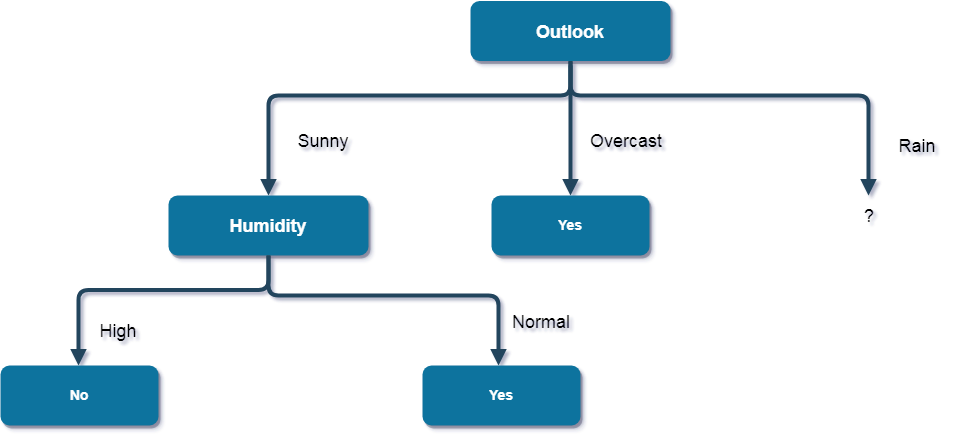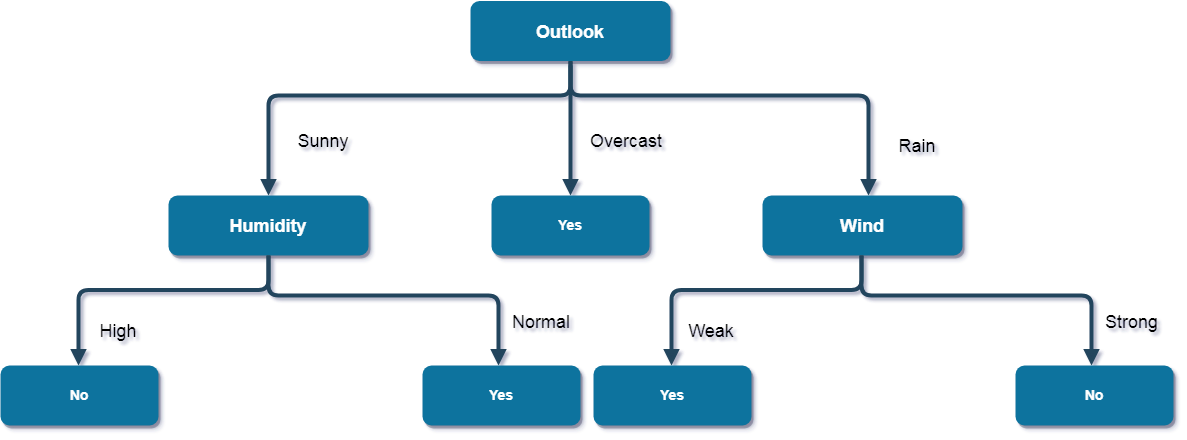ID3
algorithm
The steps
in ID3 algorithm are as follows:
- Calculate entropy for dataset.
- For each attribute/feature.
2.1. Calculate entropy for all its categorical
values.
2.2. Calculate information gain for the
feature.
- Find the feature with maximum information
gain.
- Repeat it until we get the desired tree.
Use ID3
algorithm on a data
We'll
discuss it here mathematically and later see it's implementation in Python.
So, Let's take an example to make it more clear.
|
Day |
Outlook |
Temperature |
Humidity |
Wind |
PlayTennis |
|
D1 |
Sunny |
Hot |
High |
Weak |
No |
|
D2 |
Sunny |
Hot |
High |
Strong |
No |
|
D3 |
Overcast |
Hot |
High |
Weak |
Yes |
|
D4 |
Rain |
Mild |
High |
Weak |
Yes |
|
D5 |
Rain |
Cool |
Normal |
Weak |
Yes |
|
D6 |
Rain |
Cool |
Normal |
Strong |
No |
|
D7 |
Overcast |
Cool |
Normal |
Strong |
Yes |
|
D8 |
Sunny |
Mild |
High |
Weak |
No |
|
D9 |
Sunny |
Cool |
Normal |
Weak |
Yes |
|
D10 |
Rain |
Mild |
Normal |
Weak |
Yes |
|
D11 |
Sunny |
Mild |
Normal |
Strong |
Yes |
|
D12 |
Overcast |
Mild |
High |
Strong |
Yes |
|
D13 |
Overcast |
Hot |
Normal |
Weak |
Yes |
|
D14 |
Rain |
Mild |
High |
Strong |
No |
Here,dataset
is of binary classes(yes and no), where 9 out of 14 are "yes" and 5
out of 14 are "no".
Complete
entropy of dataset is:
H(S) = -
p(yes) * log2(p(yes)) - p(no) * log2(p(no))
= - (9/14) * log2(9/14) - (5/14) *
log2(5/14)
= - (-0.41) - (-0.53)
= 0.94
For each
attribute of the dataset, let's follow the step-2 of pseudocode : -
First
Attribute - Outlook
Categorical
values - sunny, overcast and rain
H(Outlook=sunny)
= -(2/5)*log(2/5)-(3/5)*log(3/5) =0.971
H(Outlook=rain)
= -(3/5)*log(3/5)-(2/5)*log(2/5) =0.971
H(Outlook=overcast)
= -(4/4)*log(4/4)-0 = 0
Average
Entropy Information for Outlook –
I(Outlook)
= p(sunny) * H(Outlook=sunny) + p(rain) * H(Outlook=rain) + p(overcast) *
H(Outlook=overcast)
=
(5/14)*0.971 + (5/14)*0.971 + (4/14)*0
= 0.693
Information
Gain = H(S) - I(Outlook)
= 0.94 - 0.693
= 0.247
Second
Attribute - Temperature
Categorical
values - hot, mild, cool
H(Temperature=hot)
= -(2/4)*log(2/4)-(2/4)*log(2/4) = 1
H(Temperature=cool)
= -(3/4)*log(3/4)-(1/4)*log(1/4) = 0.811
H(Temperature=mild)
= -(4/6)*log(4/6)-(2/6)*log(2/6) = 0.9179
Average
Entropy Information for Temperature -
I(Temperature)
= p(hot)*H(Temperature=hot) + p(mild)*H(Temperature=mild) +
p(cool)*H(Temperature=cool)
= (4/14)*1
+ (6/14)*0.9179 + (4/14)*0.811
= 0.9108
Information
Gain = H(S) - I(Temperature)
= 0.94 - 0.9108
= 0.0292
Third
Attribute - Humidity
Categorical
values - high, normal
H(Humidity=high)
= -(3/7)*log(3/7)-(4/7)*log(4/7) = 0.983
H(Humidity=normal)
= -(6/7)*log(6/7)-(1/7)*log(1/7) = 0.591
Average
Entropy Information for Humidity -
I(Humidity)
= p(high)*H(Humidity=high) + p(normal)*H(Humidity=normal)
=
(7/14)*0.983 + (7/14)*0.591
= 0.787
Information
Gain = H(S) - I(Humidity)
= 0.94 - 0.787
= 0.153
Fourth
Attribute - Wind
Categorical
values - weak, strong
H(Wind=weak)
= -(6/8)*log(6/8)-(2/8)*log(2/8) = 0.811
H(Wind=strong)
= -(3/6)*log(3/6)-(3/6)*log(3/6) = 1
Average
Entropy Information for Wind -
I(Wind) =
p(weak)*H(Wind=weak) + p(strong)*H(Wind=strong)
=
(8/14)*0.811 + (6/14)*1
= 0.892
Information
Gain = H(S) - I(Wind)
= 0.94 - 0.892
= 0.048
Here, the attribute with maximum information
gain is Outlook. So, the decision tree built so far -
Here, when Outlook == overcast, it is of pure class(Yes).
Now, we
have to repeat same procedure for the data with rows consist of Outlook value
as Sunny and then for Outlook value as Rain.
Now,
finding the best attribute for splitting the data with Outlook=Sunny values{
Dataset rows = [1, 2, 8, 9, 11]}.
Complete
entropy of Sunny is -
H(S) = -
p(yes) * log2(p(yes)) - p(no) * log2(p(no))
= - (2/5) * log2(2/5) - (3/5) * log2(3/5)
= 0.971
First
Attribute - Temperature
Categorical
values - hot, mild, cool
H(Sunny,
Temperature=hot) = -0-(2/2)*log(2/2) = 0
H(Sunny,
Temperature=cool) = -(1)*log(1)- 0 = 0
H(Sunny, Temperature=mild)
= -(1/2)*log(1/2)-(1/2)*log(1/2) = 1
Average
Entropy Information for Temperature -
I(Sunny,
Temperature) = p(Sunny, hot)*H(Sunny, Temperature=hot) + p(Sunny,
mild)*H(Sunny, Temperature=mild) + p(Sunny, cool)*H(Sunny, Temperature=cool)
= (2/5)*0
+ (1/5)*0 + (2/5)*1
= 0.4
Information
Gain = H(Sunny) - I(Sunny, Temperature)
= 0.971 - 0.4
= 0.571
Second
Attribute - Humidity
Categorical
values - high, normal
H(Sunny,
Humidity=high) = - 0 - (3/3)*log(3/3) = 0
H(Sunny,
Humidity=normal) = -(2/2)*log(2/2)-0 = 0
Average
Entropy Information for Humidity -
I(Sunny,
Humidity) = p(Sunny, high)*H(Sunny, Humidity=high) + p(Sunny, normal)*H(Sunny,
Humidity=normal)
= (3/5)*0
+ (2/5)*0
= 0
Information
Gain = H(Sunny) - I(Sunny, Humidity)
= 0.971 - 0
= 0.971
Third
Attribute - Wind
Categorical
values - weak, strong
H(Sunny,
Wind=weak) = -(1/3)*log(1/3)-(2/3)*log(2/3) = 0.918
H(Sunny,
Wind=strong) = -(1/2)*log(1/2)-(1/2)*log(1/2) = 1
Average
Entropy Information for Wind -
I(Sunny,
Wind) = p(Sunny, weak)*H(Sunny, Wind=weak) + p(Sunny, strong)*H(Sunny,
Wind=strong)
=
(3/5)*0.918 + (2/5)*1
= 0.9508
Information
Gain = H(Sunny) - I(Sunny, Wind)
= 0.971 - 0.9508
= 0.0202
Here, the attribute with maximum information gain is Humidity. So, the decision tree built so far -

Here, when
Outlook = Sunny and Humidity = High, it is a pure class of category
"no". And When Outlook = Sunny and Humidity = Normal, it is again a
pure class of category "yes". Therefore, we don't need to do further
calculations.
Now,
finding the best attribute for splitting the data with Outlook=Sunny values{
Dataset rows = [4, 5, 6, 10, 14]}.
Complete
entropy of Rain is -
H(S) = -
p(yes) * log2(p(yes)) - p(no) * log2(p(no))
= - (3/5) * log(3/5) - (2/5) * log(2/5)
= 0.971
First
Attribute - Temperature
Categorical
values - mild, cool
H(Rain,
Temperature=cool) = -(1/2)*log(1/2)- (1/2)*log(1/2) = 1
H(Rain,
Temperature=mild) = -(2/3)*log(2/3)-(1/3)*log(1/3) = 0.918
Average
Entropy Information for Temperature -
I(Rain,
Temperature) = p(Rain, mild)*H(Rain, Temperature=mild) + p(Rain, cool)*H(Rain,
Temperature=cool)
= (2/5)*1
+ (3/5)*0.918
= 0.9508
Information
Gain = H(Rain) - I(Rain, Temperature)
= 0.971 - 0.9508
= 0.0202
Second
Attribute - Wind
Categorical
values - weak, strong
H(Wind=weak)
= -(3/3)*log(3/3)-0 = 0
H(Wind=strong)
= 0-(2/2)*log(2/2) = 0
Average
Entropy Information for Wind -
I(Wind) =
p(Rain, weak)*H(Rain, Wind=weak) + p(Rain, strong)*H(Rain, Wind=strong)
= (3/5)*0
+ (2/5)*0
= 0
Information
Gain = H(Rain) - I(Rain, Wind)
= 0.971 - 0
= 0.971
Here, the attribute with maximum information gain is Wind. So, the decision tree built so far -
 Here, when
Outlook = Rain and Wind = Strong, it is a pure class of category
"no". And When Outlook = Rain and Wind = Weak, it is again a pure
class of category "yes".
Here, when
Outlook = Rain and Wind = Strong, it is a pure class of category
"no". And When Outlook = Rain and Wind = Weak, it is again a pure
class of category "yes".And this
is our final desired tree for the given dataset.
What are
the characteristics of ID3 algorithm?
Characteristics
of ID3 Algorithm are as follows:
- ID3 uses a greedy approach that's why it
does not guarantee an optimal solution; it can get stuck in local
optimums.
- ID3 can overfit to the training data (to
avoid overfitting, smaller decision trees should be preferred over larger
ones).
- This algorithm usually produces small
trees, but it does not always produce the smallest possible tree.
ID3 is harder to use on continuous data (if the values of any given attribute is continuous, then there are many more places to split the data on this attribute, and searching for the best value to split by can be time consuming).





No comments:
Post a Comment